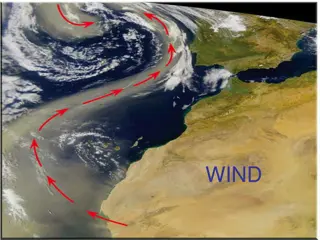Weather Map Interpretation
Weather maps provide data on various weather elements at a specific time. They show isobars, wind direction, cloud cover, rainfall, and more. Weather maps differ from synoptic charts which provide additional detailed information. Analyzing weather maps helps predict weather trends.
6 views • 7 slides
Understanding Horizontal Distribution of Air Pressure and Pressure Belts on the Globe
The horizontal distribution of air pressure and pressure belts on Earth is characterized by isobars, indicative of high and low pressure systems. The regular zonal distribution of pressure belts is affected by the uneven distribution of land and water. Pressure belts are not solely induced by temper
1 views • 7 slides
Forces Affecting Air Movement: Pressure Gradient Force and Coriolis Force
The pressure gradient force (PGF) causes air to move from high pressure to low pressure, with characteristics including direction from high to low, perpendicular to isobars, and strength proportional to isobar spacing. The Coriolis force influences wind direction due to the Earth's rotation, making
0 views • 20 slides
Understanding Wind and Atmospheric Phenomena
Wind is air in motion driven by the uneven heating of the Earth's surface. Learn about key concepts such as anemometers, isobars, pressure gradients, the Coriolis Effect, and jet streams, which all play crucial roles in meteorology. Winds are named based on their direction, and jet streams influence
0 views • 28 slides
Understanding Air Pressure Through Pressure Maps
Explore the significance of air pressure in understanding weather patterns through pressure maps. Learn to interpret isobars, identify high and low pressure areas, analyze isobar intervals, and understand how air flows from high to low pressure areas. Enhance your meteorological knowledge and grasp
0 views • 6 slides




